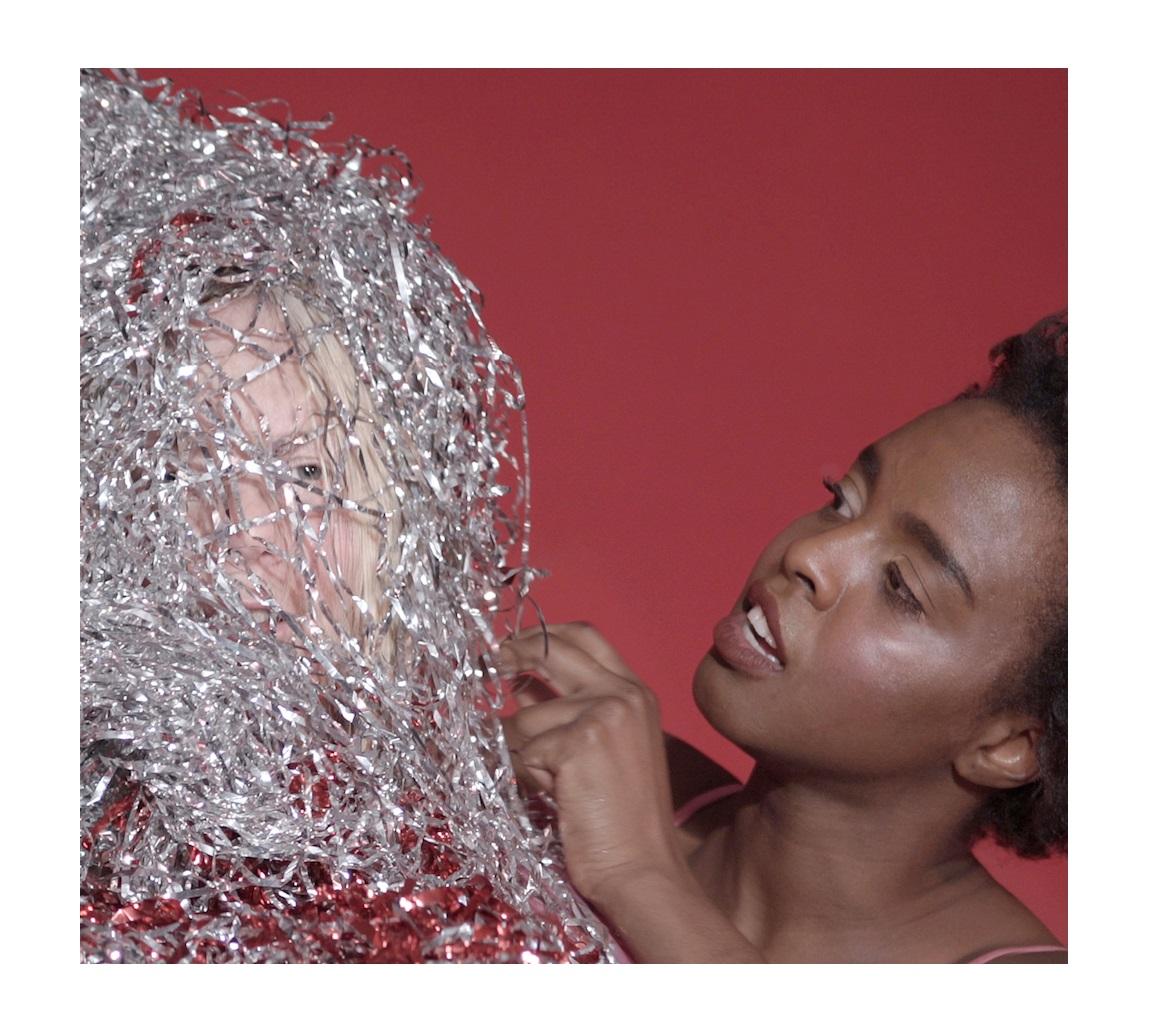
Karen Asher picks me up from my parent’s house in the suburbs. We decide to go to Rae & Jerry’s for our interview. Rae & Jerry’s is a relic of 1960’s postwar Winnipeg, a steakhouse still dimly lit and covered in red velvet and wood panel. It sticks out like a sore thumb on the city's Portage Avenue with its long, covered driveway originally used for valet service. Once the epitome of fine dining, Rae & Jerry’s now sits somewhere in between a high-class experience and a tongue-in-cheek joke.
I’m going to be speaking with Asher about her most recent exhibition, Class, at Plug In Institute of Contemporary Art. In the past, Karen worked primarily with still photography. In her website bio, Asher describes her artwork as an exploration of “her obsession with stress, absurdity and the catastrophe of everyday life.” Most of her work features the figure shot on square, medium format film. Her subjects vary from her partner, Kevin, to strangers she meets on the street, to friends piled in bed together lying half lovingly and half awkwardly, in matching outdated frilly nightgowns. There is an underlying anxiety to her photos that peaks through every beautiful composition, every loving embrace and every elated display of emotion.
In contrast to her previous work, Class is Karen’s first large scale installation featuring video, a small peephole on the wall, a fuzzy carpet, checker-board floor, large photos strewn about the floor and leaning against walls, a leather couch, disco ball, and a neon sign that flickers between saying “class” and “classy”. A familiar cast of characters--some seen in Asher’s previous photo work and some just members of the Winnipeg art scene-- dance to 80s music in front of a stark red backdrop. There is a vast emotional range to the work: switching from sensual solo dances, to joyful group dance scenes to slow dances in bondage gear.
On our way to the restaurant, Asher and I get lost; accidentally take a long detour through construction zones. She starts asking me questions about my family, my childhood, what it’s like being an adult living at home in the suburbs with my boyfriend and entire family. When we finally get to the restaurant, there’s a moment of drama at the entrance as a well-dressed woman bursts through the door on the verge of tears, followed by her two friends. “I just can’t bear for it to turn out this way! We’ve gone to all this trouble” she says to her friends. Asher and I pause. We watch them for just a little too long before realizing that this public drama is actually private and not for us. Entering the lounge, there’s a birthday party taking up the whole back section where Karen and I had hoped to sit. “Should we ask them to move?” Asher jokes.
After some back and forth with the host and a failed mic test on my phone’s recorder, we decide to try Bailey’s; an equally strange and archaic-looking restaurant. After finally finding the perfect quiet table to have our conversation, we order our food. Just as we begin our chat, a man rushes in from the street and orders a cheeseburger for takeout at the bar.
Karen Asher: I wish I could just be like that. I could never just walk in and say: “can I have that to go?”. I just can’t make it simple… I can’t talk like that. It’s a problem. I don’t know how to have a simple transaction. Even if I tried I’d start laughing and say something silly. I can’t explain it. Maybe because I also don’t want to...I always want to connect somehow. I am always interested in strangers and this kind of deeper interaction. I’m just not very good at a swift exchange.
Emma Mayer: That’s interesting. I can’t relate to that at all.
I think that’s, to a certain extent, also reflected in my artwork.
I was going to ask if your interest in strangers is a big part of your practice.
Yes strangers, everyone, everything. It’s like that with all my relationships. I am comfortable diving in quickly.
I’m not a good small talker! Well, this is kind of like small talk, but I’m not formal - ever! I don’t do formal, minimal, transactions or interactions. They always turn into bizarro-ness, generally. And it’s not to be deep. I’m not not deep, I’m not necessarily “searching for something.” I think it’s simply wanting to get past the superficial and form some even slight, strange connection, even subconsciously. And I think, hope, that maybe that’s a reflection in my art...that people will easily let their guard down because I’ve comfortably developed these connections with them.
Are your photos in the past mostly strangers? How did you find the people to pose in your photos?
It’s an array of people: friends, family, people I just come up to on the street.
There is an image with a mother smoking with her two daughters dressed up like skeletons. Were those strangers?
Oh yeah, they’re just strangers. It was Halloween. I turned the corner and they were right there, like magic before my eyes. I engage really easily and comfortably.
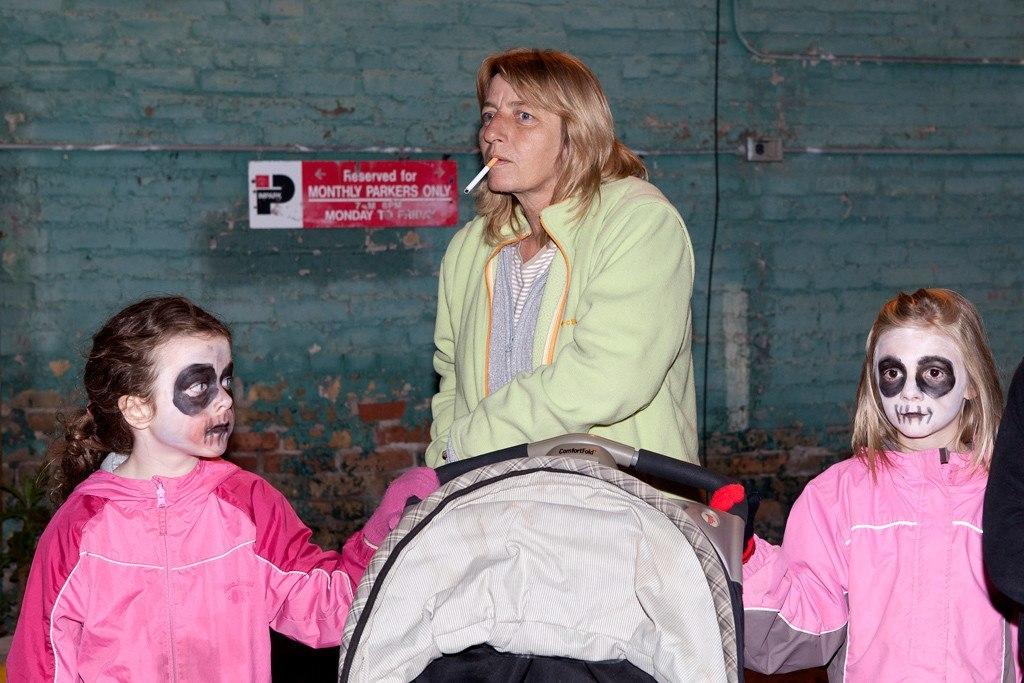
Skeleton Girls, 2010, C-Print, 36" × 24"
But that’s a real gift that a lot of people don’t have. And it’s really genuine. It’s not like, “Oh I can tell this person’s trying to milk me for something.” Usually, I’m wary of anyone who jumps right into a familiar territory. But it’s not like that.
It is a duality: I love engaging with people, but I deal with anxiety and depression. Sometimes I get holed up away in my house and forget to leave. I forget how much that drives me."My boyfriend will tell me: “you have to leave the house, you need it, you have to leave the house. You have to engage with people. That’s what energizes you.”Often I can get overwhelmed and have social anxiety, strangely, and take the back alleys to avoid people. So I do have that in me, and I confront that by using humour. I think it’s the way I deal with people to break my unease: by diving right in, it instantly makes me comfortable. And it makes me in control of the situation. I feel like if I don’t do that I start being so aware of what I’m doing and saying and I get paranoid. I always say I’m my own dancing monkey. I always have to be entertaining myself and it just puts me at ease. And I like putting other people at ease. Truly, I’m like an obnoxious bratty little kid who is so excited just going out on the street and seeing people. It’s a genuine excitement and curiosity and passion. And people get excited by that and it just becomes this interaction between myself and the other person and I think we both then thrive by it. I get excited, but people get excited when you’re doting on them. And it’s never like “Look at this weirdo.” It’s always full, not to be a total corndog, but with utmost love. It’s just this ability to engage and connect, I think, that’s most important to me.
This is your first video work. Was it different doing video this time?
I did a day and a half of shooting for the video. I had never even made a one-second video before. Everything was different. But strangely quite similar to my photoshoots too…
That’s ambitious. I get the sense that you turned on the camera and then went like “we’re going to have it going for 24 hours like a surveillance camera.”
Yeah, there was a lot of going with the flow. I shrieked a lot, stood there in shock...
i want[ed] the work to be seductive, I want[ed] the work to be entertaining. I spend my life trying to entertain people. If someone just went and was like: “Oh that was so much fun. That was hilarious. That was beautiful.” Why can’t that be good enough?
In the description of the show, it was laid out like it was a display of all your formative experiences and sort of like a love letter to the dive bars you worked in. And I liked the sex club feeling of the whole thing. But, in terms of it being kind of like a self-portrait, it’s really beautiful: that’s the love that you’re pouring out and then that is like the embodiment of the love coming back to you.
You know, when Jenifer [Papararo] described Class as a self-portrait - that became essential to the heart of the show. I thought of it that way in reference to growing up and thinking a lot about class structure, and questions like: “what class am I in?” all the weird class references and how they’ve applied to my life. I was not a good student in school, but I was a good dancer. So I thought of like, dance class and countless layers that played into this idea of what “class” means to me.
So I was referencing a lot of personal complexity but pseudo superficially… you know what I mean? Superficial, silly takes on it, but there was a deeper meaning in referencing class. I was referencing dive bars that I worked in and hung out in. Also, I was poor growing up and a really poor student as well. It wasn’t until I was in university that I kind of found my grounding and did well. But I remember my one salvation was that I was a good dancer when I was a little kid, and all my dance schools were pretty much downtown at Portage and Main. So to come back full circle and create this class-fuelled energized dance space downtown was really beautiful to me. Especially with all the warmth that the dancers generated.
What is the relationship to dance in the work? How far did you go with dance that it became so crucial?
I was a really good dancer as a little kid. Sort of danced semi-competitively - it seems funny to think of now. I went to this school called Academy of Dance. It felt like it was straight out of a New York 80s dance movie. My mom pulled me out when she found out I was afraid of the headmistress. Then I moved to the Royal Winnipeg Ballet. I took tons of classes and got plucked for solos and duos for the dance festivals. I quit when I was a young teenager. It was the early 90s and I had no interest in dance anymore and I just wanted to hang out with punks and skaters. A couple of years later I met all these beautiful girls who were contemporary dancers and sort of kicked myself. I was in my prime in elementary school and quit dance class in grade eight so that kind of feels like a past life.
Academy of Dance is where the Avenue Building is now, those apartments right on Portage. Inside it was just a giant old, old, old warehouse. The lady who ran it was kind of terrifying but amazing. She created amazing, competitive dancers. And RWB used to be one block over, exactly the same thing, in an old giant decrepit warehouse right on Portage. And then it moved to that sad pastel building and even as a little kid, I knew it wasn’t cool anymore because I liked dumpier crap. So I remember those formative years, growing up and having these breaks in between my dance classes and I would hang out at Dominion News. Because Dominion News used to be on the other side of the street right next to my dance schools.
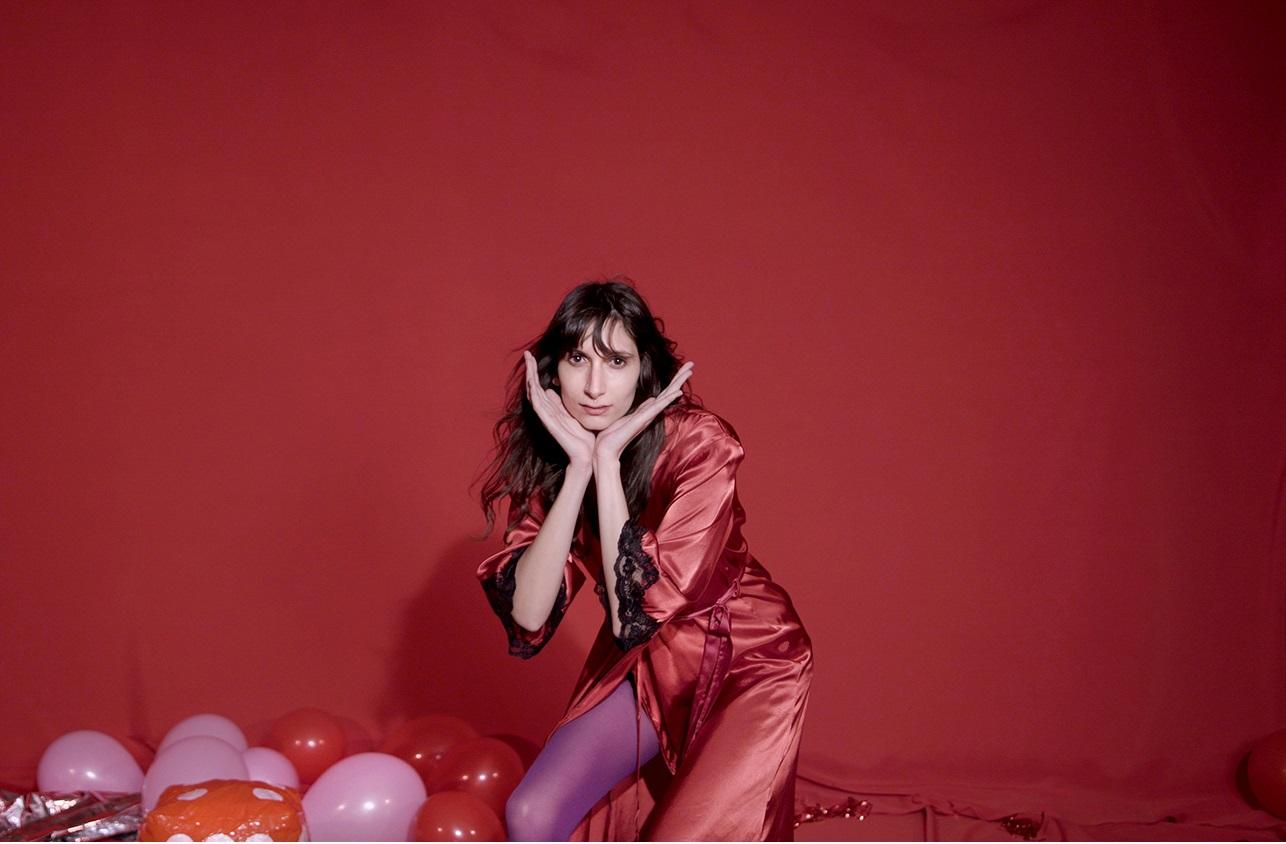
video still from Class. courtesy of Karen Asher.
Was there a glory hole there? Is that why you have the glory hole in your show?
There were rumoured glory holes. A lot of sketch backroom business. And I remember I was seven years old and I’d have a two-hour break between ballet and jazz, and I’d be in a bodysuit hanging out in Dominion News, eating candy. And I just knew there were all these dirty magazines and I just knew it was exciting and I didn’t care - I knew, I knew all that shit. So I hung out on the streets, I felt like I owned the streets and I felt like that really gave me a strong identity of who I was and who I was to become. I felt comfortable hanging out with all kinds of people - sketchies, weirdos, people on the street shooting the shit with everyone and not fearing anyone. I pretty much grew up dancing downtown and never left. So I wanted the gallery environment to kind of reference downtown, glory holes, dive bars, and especially Wellingtons, which was a bar I worked at in the mid-90s - it was on Albert. I loved it. And then Jenifer made this reference - she wanted me to take the photos off the wall and experiment with the gallery space.
How did you approach doing an installation? What was your process for finding locations and people [for photos] before, compared to having to come up with all the items and the props and the fabrication?
I always wanted to make a video so that was the first thing in my head. Something stripped down, red, and a space for people to move and dance. Referencing the very basics of voyeurism, people-watching: putting the camera on and how that plays out when you simply just watch someone. I just thought that would be intriguing and I knew it would be little vignettes referencing physicality and emotion. I’m always kind of doing that in my photography so I was excited to push that further - without having to stop or create just one frame.
I wanted the gallery completely transformed. From the start, I wanted the video to be red. I just thought the fleshy skin against the red would be gory, sexy, sensual and smutty. I also I wanted the floors to be checkered because I’m obsessed with checkered floors and I’m obsessed with vertical stripes. I thought it would be like a circus… like “Step right up!” Wild and untamed.
Most importantly, I wanted you to feel like you were walking into a club. I was adamant that we had to get velvet curtains. I wanted it to feel lush. It was really hard to find those curtains, it was brutal trying to locate them. And it accidentally made the space extra hot and sweaty.

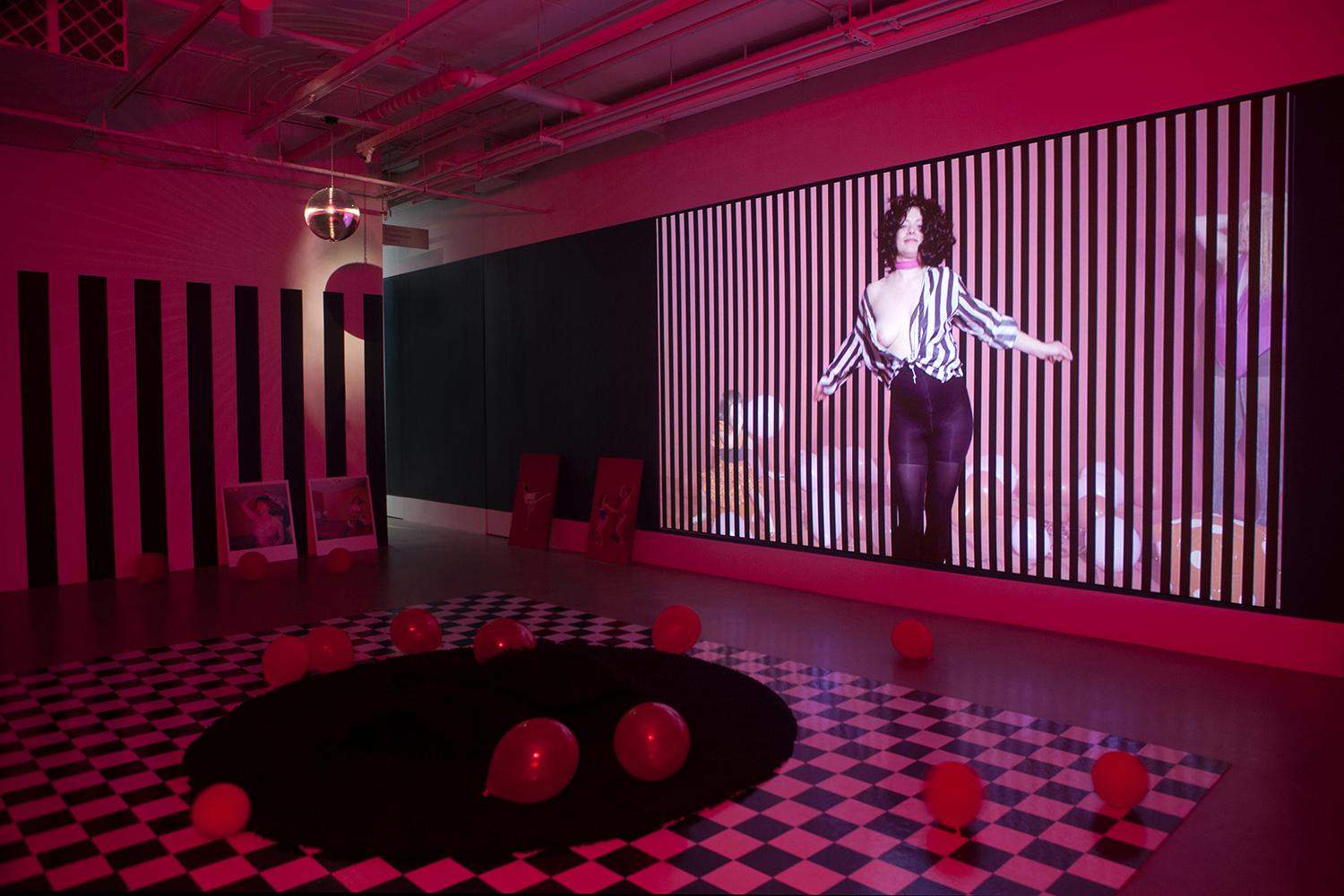

Installation views from Class. courtesy of Karen Asher.
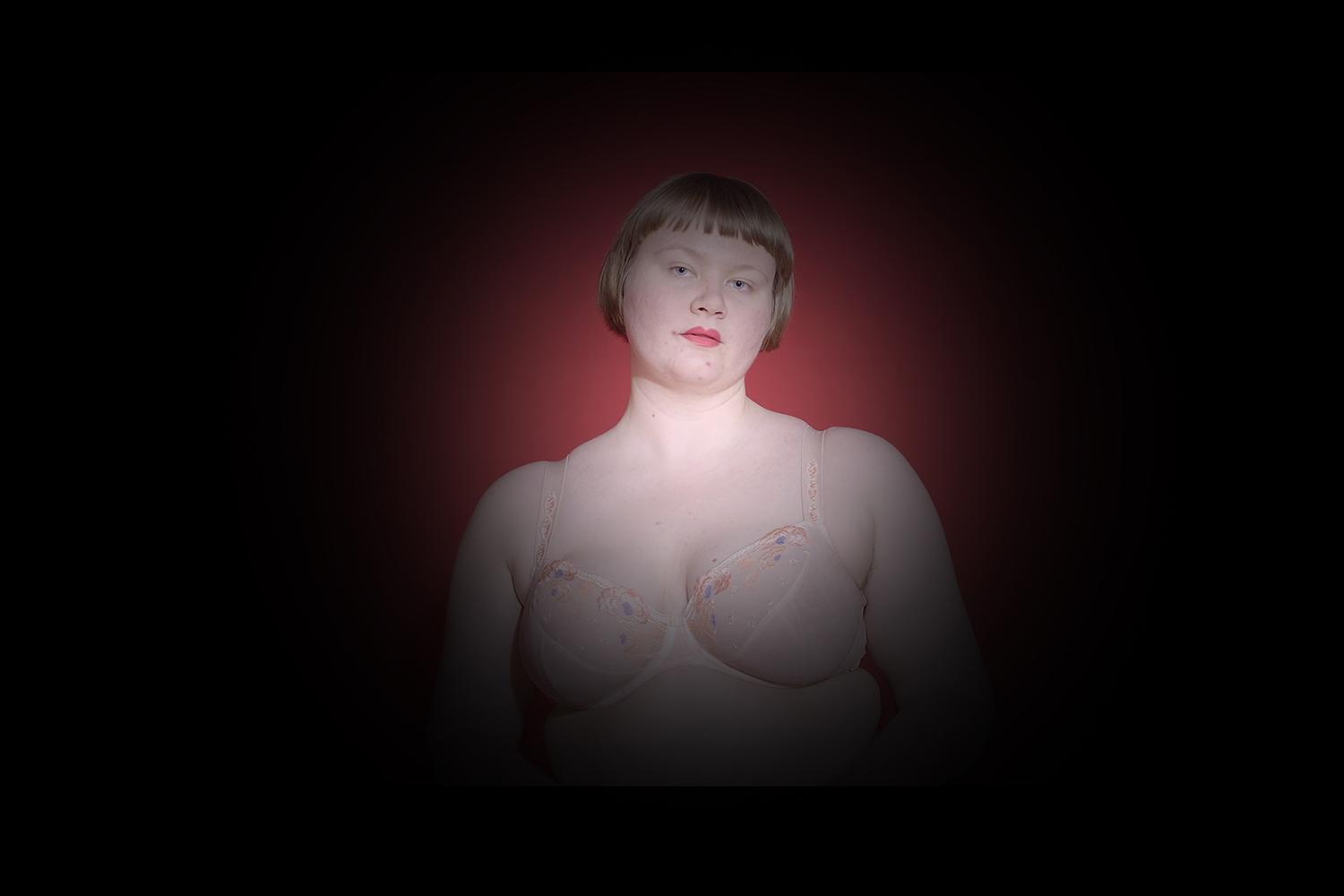
video still from Class. courtesy of Karen Asher.
Voyeurism seems to be a recurrent theme in your work, to a certain extent. I always get the sense that you’re really in it. It doesn’t feel like you’re making fun of people.
Oh god no! Beforehand, in my photography, whenever I showed someone my contact sheet and they’d be like, “Oh my god, that’s hilarious! Use that one!” That’s always the one I would never use. If it hits you over the head and it’s going to be funny for one minute… I have no interest in it. I often like the subtlety in capturing the in-between moments that resonate and ask more questions. I’ve always kind of been drawn to that. Never a one-liner.
I guess my question was about you as a voyeur. What do you feel like your relationship to that is?
I’ll admit, I always feel like I’m an agent of chaos. I’m a little shit everywhere I go. I cause trouble just to entertain myself. And of course, I do that in my art, because I have to stir up things to start to watch things unfold. And I love that because… I was thinking if I could say one thing about this work, it’s that I want to seduce people. I want the work to be seductive, I want the work to be entertaining. I spend my life trying to entertain people. If someone just went and was like, “Oh that was so much fun. That was hilarious. That was beautiful.” Why can’t that be good enough?
I love looking and staring and just watching, and that’s kind of like the weird privilege to be able to just sit and watch. And I want you to feel, to a certain extent, like you’re in a club and this is almost the entertainment. But they’re not dancing for you, because you’re never really acknowledged. It’s just a heightened celebration of themselves, their bond, their enjoyment, and their passion.
Voyeurism is such a weird word, but I also think it’s okay to look and just be seduced. Rineke Dijkstra is an artist...I don’t know many artists so I don’t throw around fancy names...but I saw this video [by her] that I never got out of my mind. She would go to dance clubs in the Netherlands and all over Europe. It was the 90s and she’d go to rave clubs and she’d pull people out and have a white background and she would just film them to the music. They’d often start out really awkward and eventually, they’d just go, “fuck it!” and go whole hog. And the simplicity of just this plain background, watching the awkwardness, the vulnerability and then seeing them lose themselves in the music and in the moment: I found it so intoxicatingly beautiful. I became interested in capturing what happens if you just bring a bunch of people together and watch what transpires. Creating something out of nothing is what I love more than anything. I’ve thought of that in my photography and I’ve thought of that in this video. A plain empty room and just that idea of creating something out of nothing, of coming in without a plan and watching the magic unfold. It’s hilarious to watch the final piece with all the edits..so slick compared to the original mess but a mess nonetheless.
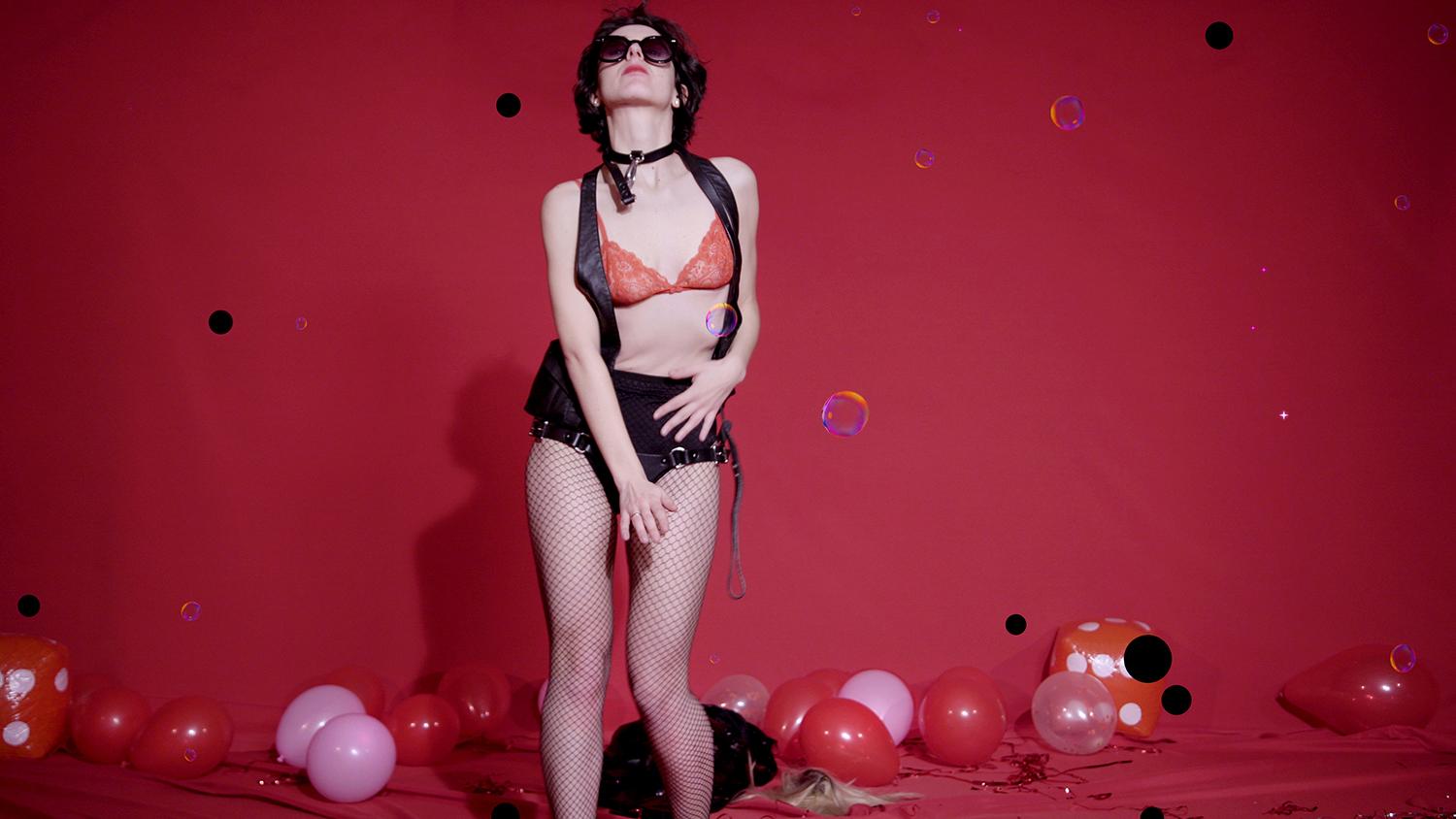

video still from Class. courtesy of Karen Asher.
There’s also an emphasis on kink in the work.
Not intentionally it just played out that way. It felt like when dudes all bro-down together, but opposite. There was kind of this energy that happened in the room the day we taped, just loving, fun, sexy, especially when Elise came by. She came to play. She walked in, dropped her clothes and then many followed suit. It was kind of unintentional united sexytime. I think that just happens naturally when you bring a bunch of people together and the atmosphere is really loving and supportive and sexy, everyone starts loosening up and letting their guard down. I had no idea it would go this way. My friend came up to me just in her underwear and was like, “When’s my solo? I’ve been in the bathroom pinching my nipples rearing to go!” And I was like, “What?!” And people were all like, “I have an idea! I have an idea!” People were all wanting to do their own thing and had ideas. So it took on a life of its own. It went in mad and mysterious directions I did not plan for. And in terms of the whole idea of voyeurism, I have footage where it goes a little extreme. Even for me.
So there was a line.
Of course. There’s footage that will never see the light of day. And I’m super sensitive. Anything that was even remotely sexual, with any nudity, was approved way after the fact. Sober. I check double check, triple check. Yes, there was drinking. It was the night before New Year's Eve. I brought pizza and soda and alcohol and candy, and obviously alcohol softens the blow and makes people more comfortable, I’m not a fool. But people also wanted to have fun & party...people showed up with bottles...people showed up tipsy...it was the holidays...and everyone’s adults… and people know the intimacy of my process. So yes, while the taping went in a few saucy directions I definitely didn’t foresee, it’s always my responsibility to check that any sensitive footage is approved.
So I did see that Ming [Asher’s best friend and dancer] had a dance that was interrelated? Was that something that you were involved with?
She responded to the work. We had talked about how she would use the space and respond to it, so she kind of addressed the neon… when you walk in, there’s the neon, and I really wanted to do a neon, but I’m like, “I can’t do a neon. It’s so corny to do a neon in my own space…” But I’m making a spoof on a neon, but I’m still making a neon. So either way, you slice it… It was funny.
But I also did it because the whole thing of calling it Class was the fine line of who defines class and what’s classy and one man’s classy is another man’s trashy. I mean it’s all a bit sassy. People spend all their money on these weddings that have these giant neon colourful decorations that I think are gorgeous but by so many other standards they’d be hideous. These things to me are so gorgeous but they’re so fantastically tacky in ways and I think it’s amazing how we determine class. And I am interested in class structure so this was a bit of a “fuck you” because I grew up very working class and I feel like I always know my place, even though I have success in Winnipeg. I always know where I stand. So I felt like I was being a little shit calling my show Class.

Installation view from Class. courtesy of Karen Asher.